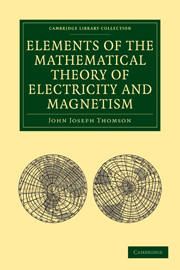Book contents
- Frontmatter
- PREFACE TO FIRST EDITION
- PREFACE TO THE SECOND EDITION
- PREFACE TO THE THIRD EDITION
- PREFACE TO THE FOURTH EDITION
- Contents
- CHAP. I General Principles of Electrostatics
- CHAP. II Lines of Force
- CHAP. III Capacity of Conductors. Condensers
- CHAP. IV Specific Inductive Capacity
- CHAP. V Electrical Images and Inversion
- CHAP. VI Magnetism
- CHAP. VII Terrestrial Magnetism
- CHAP. VIII Magnetic Induction
- CHAP. IX Electric Currents
- CHAP. X Magnetic Force due to Currents
- CHAP. XI Electromagnetic Induction
- CHAP. XII Electrical Units: Dimensions of Electrical Quantities
- CHAP. XIII Dielectric Currents and the Electromagnetic Theory of Light
- CHAP. XIV Thermoelectric Currents
- CHAP. XV The Properties of Moving Electric Charges
- INDEX
CHAP. IX - Electric Currents
Published online by Cambridge University Press: 07 September 2010
- Frontmatter
- PREFACE TO FIRST EDITION
- PREFACE TO THE SECOND EDITION
- PREFACE TO THE THIRD EDITION
- PREFACE TO THE FOURTH EDITION
- Contents
- CHAP. I General Principles of Electrostatics
- CHAP. II Lines of Force
- CHAP. III Capacity of Conductors. Condensers
- CHAP. IV Specific Inductive Capacity
- CHAP. V Electrical Images and Inversion
- CHAP. VI Magnetism
- CHAP. VII Terrestrial Magnetism
- CHAP. VIII Magnetic Induction
- CHAP. IX Electric Currents
- CHAP. X Magnetic Force due to Currents
- CHAP. XI Electromagnetic Induction
- CHAP. XII Electrical Units: Dimensions of Electrical Quantities
- CHAP. XIII Dielectric Currents and the Electromagnetic Theory of Light
- CHAP. XIV Thermoelectric Currents
- CHAP. XV The Properties of Moving Electric Charges
- INDEX
Summary
168. Let two conductors A and B be at different potentials, A being at the higher potential and having a charge of positive electricity, while B is at a lower potential and has a charge of negative electricity; then if A is connected to B by a metallic wire the potential of A will begin to diminish and A will lose some of its positive charge, the potential of B will increase and B will lose some of its negative charge, so that in a short time the potentials of A and B will be equalized. During the time in which the potentials of A and B are changing the following phenomena will occur: the wire connecting A and B will be heated and a magnetic field will be produced which is most intense near the wire. If A and B are merely charged conductors, their potentials are equalized so rapidly, and the thermal and magnetic effects are in consequence so transient, that it is somewhat difficult to observe them. If, however, we maintain A and B at constant potentials by connecting them with the terminals of a voltaic battery the thermal and magnetic effects will persist as long as the connection with the battery is maintained, and are then easily observed.
- Type
- Chapter
- Information
- Elements of the Mathematical Theory of Electricity and Magnetism , pp. 283 - 328Publisher: Cambridge University PressPrint publication year: 2009First published in: 1895

